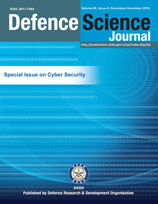Effect of Rotor Blade Geometry on the Performance of Rotary-Winged Micro Air Vehicle
DOI:
https://doi.org/10.14429/dsj.66.9659Keywords:
Micro air vehicles, Low Reynold’s number, aerodynamic performance, micro rotorAbstract
The development of physics based analysis to predict the hover performance of a micro rotor system meant for a hover capable micro air vehicle for studying the role of blade geometric parameters (such as planform, twist etc.) is discussed. The analysis is developed using blade element theory using lookup table for the sectional airfoil properties taken from literature. The rotor induced inflow is obtained using blade element momentum theory. The use of taper seems beneficial in improving the hover efficiency for lower values of thrust coefficient. For rotors operating at high thrust conditions, high negative twist is desirable. There is no unique blade geometry which performs well under all thrust conditions. This well validated analysis can be used for design of hover capable micro air vehicles.
Downloads
Published
How to Cite
Issue
Section
License
 Where otherwise noted, the Articles on this site are licensed under Creative Commons License: CC Attribution-Noncommercial-No Derivative Works 2.5 India
Where otherwise noted, the Articles on this site are licensed under Creative Commons License: CC Attribution-Noncommercial-No Derivative Works 2.5 India


